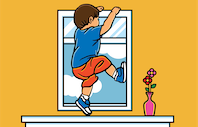Y1. Lesson 25. Barlines and 2-metre
Prior learning: Rhythm
Duration: 30 minutes
Materials:
Keywords: Beat, rhythm, singing, chanting, partners, rhymes, circle games.
Difficulty: ![]()
Prepare
Present
Barlines and 2-metre
Practise
Form
 Four steps are needed to teach bar lines and duple [2] metre, which are shown in the diagram.
Four steps are needed to teach bar lines and duple [2] metre, which are shown in the diagram.
- Show the strong beats (marked with an x) above the ta and ti-ti rhythm syllables.
- The pattern of strong and weak beats is two, so write 2 in front of the syllables.
- Remove the crosses and replace them with barlines. Add a barline at the end to let students know the music has finished.
- As the 2 has already indicated a pattern of strong and weak beats, remove the first barline (now superfluous) and place it at the end, creating a double barline.
These steps can be taught sequentially over a number of lessons for practice and reinforcement of learning.
 Melodic development
Melodic development
![]() Students practice their melodic skills by singing a new version of a song.
Students practice their melodic skills by singing a new version of a song.
- Students may be familiar with the simpler version of this song, whereby the leap in notes on the line "I can sing high..." is an octave.
- The next level up, so to speak, is unconsciously practising the fifth, moving from the tonic down to the fifth on the line on the line "I can sing high..."
- The class is seated and attentive.
- Explain to students that they are going to discover a new version of a song they may already be familiar with.
- Lead the class in singing the song line-by-line until secure.
- This is a good song to practise pitch and reinforce tuneful singing.

 Rhythmic development
Rhythmic development
![]() Students discover barlines and 2-metre.
Students discover barlines and 2-metre.
Step 1
![2 metre [step 1] 2 metre [step 1]](https://young-maestro.com/wp-content/uploads/2023/07/2-metre-step-1.png)
Step 2
![2 metre [step 2] 2 metre [step 2]](https://young-maestro.com/wp-content/uploads/2023/07/2-metre-step-2.png)
- Students are seated and attentive.
- As you sing, draw the rhythm names of ta & ti-ti for the first four bars of Rain Rain on the board. [Step 1]
- Ask students to repeat with you, using body ostinato to show the strong and weak beats. For example, strong beats can be shown as touching heads and weak beats as touching knees.
- Ask students how we could show the strong and weak beats on the board.
- Draw crosses above the strong beats and ask students what the pattern is.
- Receiving correct answers of two, teach that musicians need to know this number, so write the numeral 2 in front of the first beat. This means the song's time signature is in 2-metre.
- Explain that musicians use special lines, called barlines, which replace the crosses.
- Rub out the crosses and replace them with barlines. [Step 2]
- Explain that these lines go in front of every strong beat.
- Tell students that a barline is placed at the end of the music to stop musicians from getting lost!
- Teach that as the number 2 already tells us the first beat is strong, we remove it and place it at the end, making a double barline.
- This may be a lot of information to digest, so this knowledge will be reiterated in forthcoming lessons, giving students time to understand and practise.
 Creative movement
Creative movement
![]() Students sing and weave in and out in this circle game.
Students sing and weave in and out in this circle game.
- Students are in a circle, with their arms raised and holding the hands of the students to their left and right to form the 'windows'.
- A chosen student will weave in and out between the 'windows' as the class sing the song.
- When finished, the student then faces the person nearest them, who takes over the role.

 Listening
Listening
![]() Students discover a rhyme that has a fingerplay, for fine locomotor practise.
Students discover a rhyme that has a fingerplay, for fine locomotor practise.
Here is the church*, and here is the steeple.
Open the doors, and here are the people.
Here is our chaplain*, going up the stairs.
And here she is, saying her prayers.
* Note: Please substitute any terms appropriate to your school.
- Speak in a measured cadence to keep the beat. Teach the rhyme and act out the hand play as per the video. This will take a few repetitions.
- Select a student to come to the front and recite the rhyme along with the hand actions.
- Ask the class for feedback on the student's performance, such as “How were the words? Could you understand all the words? How were the actions? Did they have all the actions right?"
- Praise the student for trying.
- Repeat with other students as time permits.
- Finally, instruct the whole class to recite the rhyme along with the finger play.
 Visual learning
Visual learning
![]() Students develop and practise form using visual cues.
Students develop and practise form using visual cues.
- When explaining form, students are taught that a song can consist of two or three parts. The first part is given the letter A, the second part the letter B. Sometimes there is a third part with the letter C.
- The graphic to the left can be projected on the board.
- Working on the principles of same or different, ask students to identify the first line - is it AB, ABA or ABC? [ABA].
- Explain the first house can be called A. What would the next house be called? [B] - and the third house, is it the same or different as the first house?
- Go through the other three lines and ask students to identify whether they are AB, ABA or ABC?
- Ask students to explain how they achieved their answers.

 Instruments
Instruments
![]() Students discover how to play a classroom song with xylophones and marimbas.
Students discover how to play a classroom song with xylophones and marimbas.
- Distribute glockenspiels and marimbas in your usual fashion. Substitutions for these instruments are perfectly acceptable.
- Begin by leading the class in singing the song.
- Teach the melody on the glockenspiel in two-bar phrases.
- When secure, teach the ostinato on the marimba.
- When secure, ask both sets of players to commence playing on your command.
- Conduct the song in duple metre.
- Assess each group for timing and accuracy of playing.
- Offer gentle guidance as required.
 Part work
Part work
![]() Students use creative movement in response to different types of music.
Students use creative movement in response to different types of music.
Animals: Encourage students to move like different animals while holding the scarves. For example, they can pretend to be a fluttering butterfly, slithering snake, or a galloping horse.
Elements of nature: Have students use the scarves to represent natural elements like wind, rain, waves, or fire. They can twirl, sway, or flick the scarves to mimic the movements of these elements.
Superheroes: Let students wear scarves as capes and pretend to be superheroes flying through the sky, saving the day, and performing daring feats.
Storytelling: Play a piece of instrumental music and encourage students to create a story using the scarves as props. They can act out the story, taking turns playing different characters or roles.
Seasons: Use the scarves to explore the changing seasons. Students can pretend the scarves are falling leaves in autumn, snowflakes in winter, blooming flowers in spring, or the sun's rays in summer.
Magical creatures: Have students imagine that the scarves have magical powers. They can pretend to be wizards, fairies, or other magical creatures using the scarves to cast spells, fly, or create fantastical worlds.
Emotions: Encourage students to use the scarves to express different emotions. They can dance and move to the music, using the scarves to show happiness, sadness, excitement, or any other emotion they feel.
Space exploration: Students can pretend the scarves are spaceships, asteroids, or comets as they explore outer space, visiting different planets and encountering aliens.
Colours and shapes: Have students create various shapes with their scarves, such as circles, triangles, or squares, and explore how the different colours of the scarves can represent different emotions or ideas.
Cultural dances: Introduce students to different cultural dances and use the scarves as props to help them learn and imitate the movements.
- Provide each student with a light scarf or piece of fabric.
- Play music from the audio player and encourage the class to move and dance with their scarves.
- There are five examples of different music for demonstration purposes.
- This activity promotes creativity and motor skills while encouraging students to explore different ways to move with the music.
 Assess
Assess
Suggested lessons
Y1. Beat II

Y1. Beat III

Y1. Beat IV

